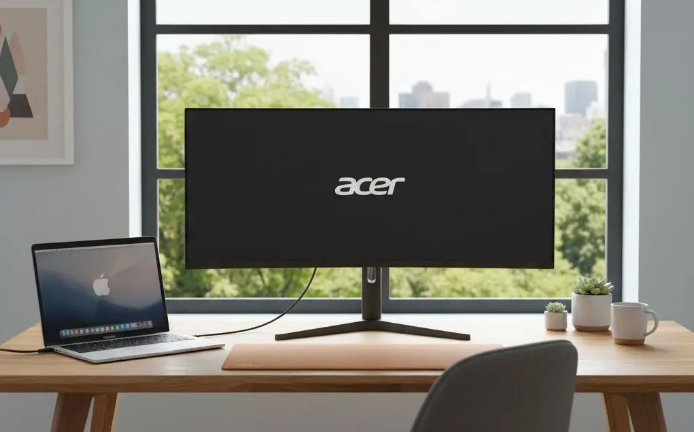How Fix An Acer Monitor That Will Not Turn On And Restore Display
If your Acer monitor suddenly refuses to power on, it can be frustrating and worrying. Thankfully, most cases come down to simple fixes. With a careful step by step approach, you can usually identify the issue without needing immediate repairs. Below is a comprehensive guide that moves from the most basic checks to more advanced troubleshooting, ensuring you don’t overlook anything.

Start with the basics: power source and cables
The most common culprit is a loose or faulty connection.
- Ensure the power cable is firmly seated in both the monitor and wall socket. Sometimes it only looks connected but isn’t snug.
- Test a different wall outlet. Avoid using surge protectors or extension cords at first since they can fail.
- If your monitor uses a detachable IEC power cable, try swapping it with another one from a PC or printer.
- For models with a power brick, test with another compatible adapter if you can.
Taking these steps eliminates simple power delivery issues before diving deeper.
Restart the computer and test again
Sometimes the monitor itself is fine but the connected computer has frozen or failed to initialize its display output.
- Perform a full restart of your computer or laptop.
- If possible, connect the monitor to another computer or device before assuming it is faulty.
- A simple reboot often refreshes the video signal and corrects temporary conflicts.
Check display settings on your computer
If the monitor powers on but still shows no image, it might not be recognized.
- On Windows, right-click the desktop and choose “Display Settings.” Scroll to the section where multiple displays are listed and click “Detect.”
- On macOS, go to “System Settings” > “Displays” and hold Option to reveal the “Detect Displays” button.
- Make sure the correct input source is selected on the Acer monitor itself (HDMI, DisplayPort, etc.).
This ensures your system is actually trying to send a signal to the Acer screen.
Update or reinstall graphics drivers
Outdated or corrupted drivers can prevent the computer from sending video to your monitor.
- On Windows, open Device Manager, expand “Display Adapters,” right-click your GPU, and choose “Update Driver.”
- On macOS, ensure you are running the latest system update.
- If problems continue, uninstall the graphics driver and reinstall the latest version directly from your GPU manufacturer (Intel, NVIDIA, AMD).
Watch the power button and indicator light
Every Acer monitor has a physical power button, usually along the bezel or underneath the panel.
- Press and hold the power button for three to five seconds, then release. Press once again to toggle.
- Observe the indicator LED.
- If it stays off, power is not reaching the monitor.
- If it briefly lights up then fades, the unit may be going into standby.
- If it flashes, it often signals a connection or internal error.
A dead LED usually points toward power supply or cable issues, while a blinking one may suggest input or firmware conflicts.
Verify video input connections
Sometimes the monitor powers on but receives no signal, leaving the screen black.
- Check the HDMI, DisplayPort, VGA, or DVI cable is firmly connected.
- Swap cables with a spare to rule out a faulty one.
- Try different input ports on both the monitor and the computer.
- Use a second device such as a laptop or game console to confirm the monitor can display input at all.
If the monitor powers up with another device, the issue lies with your computer’s graphics output, not the monitor.
Reset monitor settings
Acer monitors can sometimes lock up due to firmware or configuration errors.
- Disconnect the monitor from power completely. Unplug the cable and hold the power button for 30 seconds to discharge internal circuits.
- Plug it back in and power on. This acts like a soft reset.
- If your model has an on-screen menu accessible when it does power, navigate to “Reset” or “Factory Reset” to restore original settings.
This can clear glitches that prevent normal startup.
Inspect for hardware issues
If the above doesn’t solve it, hardware may be at fault.
- Look closely at the power brick or internal adapter for unusual warmth, smell, or noise.
- Shine a light through the screen to see if a faint image appears. If so, the backlight may have failed.
- Examine ports for bent pins or debris.
- If the monitor briefly powers then shuts down, the internal power board or capacitors could be failing.
At this stage, replacement parts or professional repair may be necessary.
Additional methods that sometimes help
- Update or reinstall your graphics drivers on the PC, since a mismatched resolution can prevent display.
- Disconnect all peripherals from your computer and test only with the monitor and keyboard.
- Try the monitor in another environment, like a friend’s computer, to isolate whether it’s the display or your system.
When to seek service
If you have completed all steps without success, the issue is likely inside the monitor’s power board, inverter, or backlight system. These components require repair skills and specialized tools. Acer offers warranty service, and local electronics repair shops can often replace faulty capacitors or boards at lower cost.
Final thoughts
Most Acer monitors that fail to turn on are revived through simple steps: reseating cables, trying new outlets, or resetting the unit. While hardware failures do occur, they are less common than loose connections or faulty cords. By moving through this checklist methodically, you can save time and money, and only turn to professional repair when truly necessary.